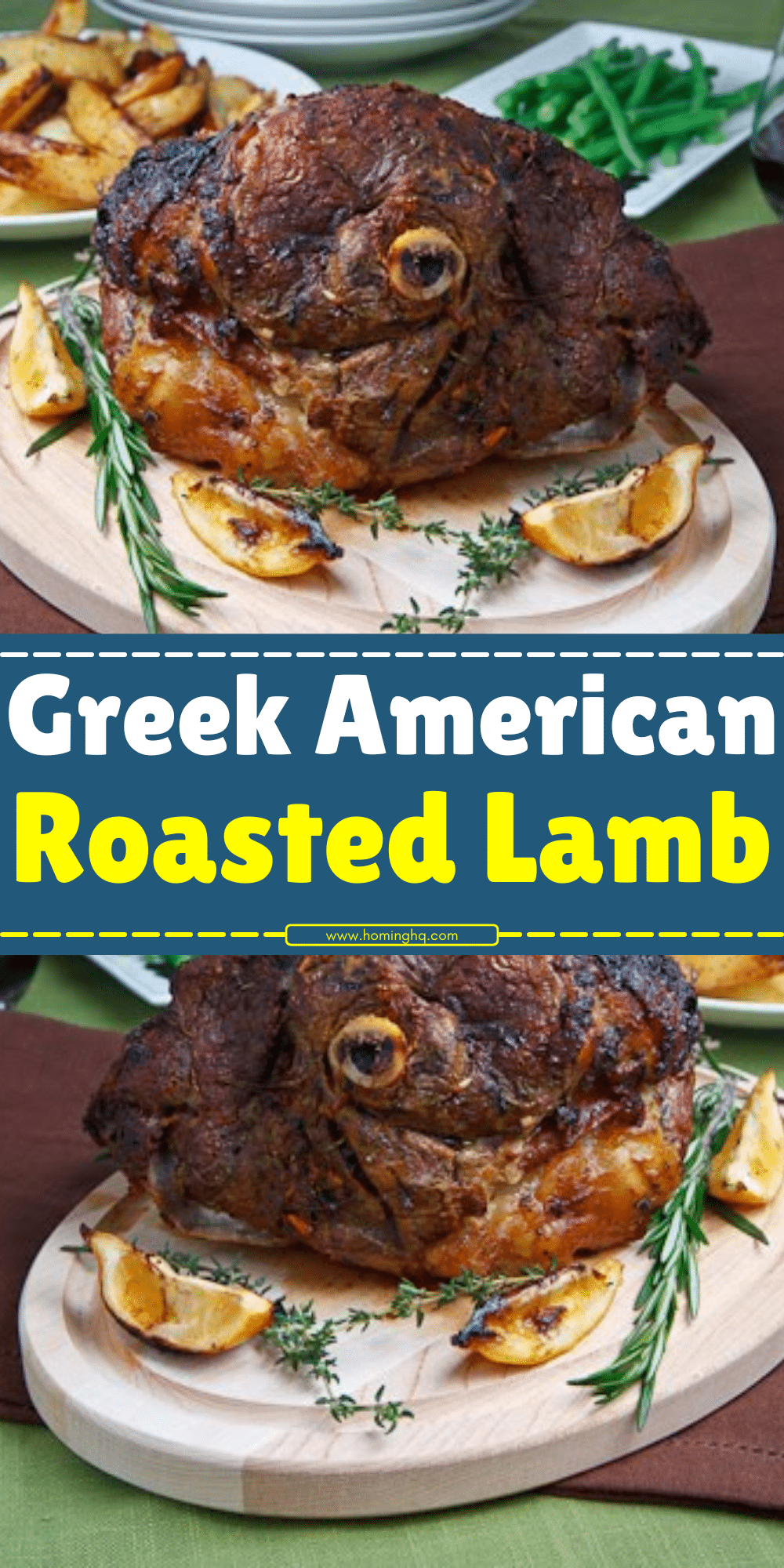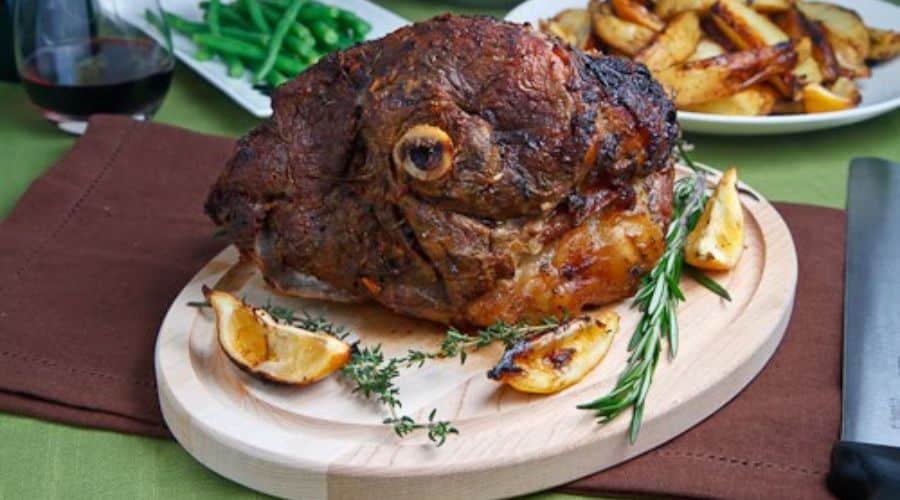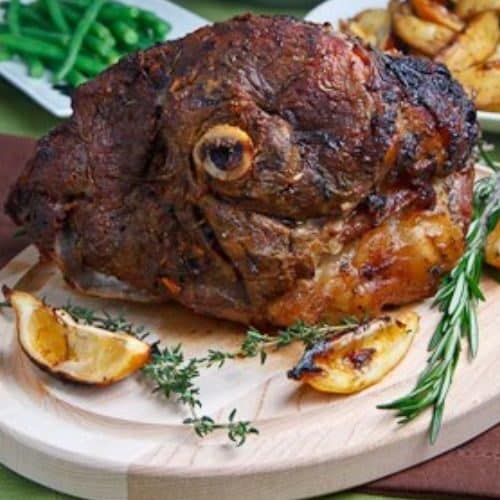All products are selected by our editorial team for quality. If you buy through our links, we may earn a small commission at no extra cost to you.
Greek-American Roasted Lamb is a dish that marries the bold and vibrant flavors of Greek cuisine with the comforting, hearty tradition of American roasting.
Known for its tender, juicy meat and aromatic seasonings, this dish has become a beloved favorite in Greek-American households.
Whether prepared for a festive occasion, holiday gathering, or a cozy family dinner, the roasted lamb offers a perfect balance of rich flavors, with the warmth of Mediterranean herbs complemented by the simplicity of American roasting techniques.
In this recipe, we will guide you through the steps of preparing this mouthwatering dish, from choosing the right cut of lamb to serving it with delicious sides.

What is Greek-American Roasted Lamb?
Greek-American Roasted Lamb is a fusion dish that takes the best of Greek cooking and blends it with American culinary techniques, particularly roasting.
In Greek cuisine, lamb is a staple, often cooked with bold flavors such as garlic, lemon, olive oil, and fresh herbs like rosemary and oregano.
These elements are carried over in Greek-American variations, where the lamb is roasted to perfection, often alongside hearty vegetables like potatoes and carrots.
The influence of Greek immigrants in America has resulted in a unique version of lamb that speaks to both cultural traditions.
While traditional Greek lamb might be slow-cooked or grilled, the American adaptation often incorporates more accessible roasting methods, making it easier for home cooks to replicate.
The dish is often enjoyed during holidays and celebrations, embodying the warmth of both Greek hospitality and American family gatherings.
Key Ingredients for Greek-American Roasted Lamb
Lamb: The Star of the Dish
The lamb is the focal point of this recipe.
Typically, a leg of lamb or shoulder is chosen for roasting, as these cuts are tender, flavorful, and perfect for slow-cooking.
A well-marbled piece of lamb will result in juicy and succulent meat. Depending on your preference, you can also use a bone-in or boneless cut, though bone-in cuts often add more flavor and richness.
Herbs and Spices
The herbs and spices used in Greek-American Roasted Lamb bring the Mediterranean to your kitchen. Essential ingredients include:
- Oregano: A quintessential Greek herb that imparts a warm, earthy flavor.
- Thyme: Often used in both Greek and American dishes, it adds a subtle floral note.
- Rosemary: A bold, fragrant herb that pairs beautifully with lamb.
- Garlic: No Greek dish is complete without garlic, which infuses the lamb with a savory depth.
- Lemon: The bright acidity of lemon adds a refreshing contrast to the richness of the lamb.
A good balance of these herbs and spices will bring out the lamb’s natural flavors while adding that signature Mediterranean touch.
Additional Ingredients
- Olive Oil: Used to marinate the lamb, olive oil is essential for both flavor and moisture.
- Vegetables: Roasting the lamb with potatoes, carrots, and onions creates a delicious medley of flavors that complement the meat. The vegetables soak up the juices and become tender, making them a perfect side.
- White Wine or Stock: Sometimes, a splash of white wine or lamb stock is added to the roasting pan to enhance the flavors and provide moisture during the cooking process.
Preparation Steps for Greek-American Roasted Lamb

Preparing the Lamb for Roasting
To get the lamb ready for roasting, start by trimming any excess fat, leaving just enough to ensure the meat stays juicy during cooking.
The next step is marinating the lamb.
This is an essential part of the process, as it allows the lamb to absorb all the flavors from the garlic, herbs, and olive oil.
To marinate:
- Mix olive oil, lemon juice, minced garlic, and your chosen herbs in a bowl.
- Rub the mixture generously over the lamb, making sure it’s well-coated.
- For the best flavor, let the lamb marinate for at least 2 hours, though overnight marination is ideal.
Preparing the Roasting Pan
While the lamb marinates, prepare the roasting pan by lining it with vegetables. Sliced onions, carrots, and potatoes are perfect choices. Not only do these vegetables add flavor to the lamb as they roast, but they also absorb the lamb’s juices, making them irresistible when served alongside the meat.
Ensure that the vegetables are evenly spread in the pan, creating a cozy base for the lamb. You can also drizzle a bit of olive oil over the vegetables and season them with salt, pepper, and extra herbs if desired.
Preparing for Roasting
Before placing the lamb in the oven, make sure the oven is preheated to around 375°F (190°C) for an even roast.
Place the lamb on a rack in the pan, so the heat circulates evenly around the meat. The lamb should be left uncovered to ensure a beautifully crisp and golden-brown exterior.
Roast the lamb according to its size, typically around 1.5 to 2 hours for a medium-sized leg, adjusting for your desired level of doneness.
For extra tenderness, you can baste the lamb every 30 minutes with the pan juices, ensuring it stays moist and flavorful throughout the roasting process.
How to Serve Greek-American Roasted Lamb
Traditional Greek Side Dishes
When serving Greek-American Roasted Lamb, it’s important to pair it with sides that complement the rich flavors of the lamb.
The classic Greek accompaniments elevate the meal and bring a refreshing balance to the dish.
- Greek Salad: A vibrant combination of tomatoes, cucumbers, red onions, olives, and feta cheese, dressed with olive oil and oregano, offers a crisp contrast to the tender lamb.
- Tzatziki: This creamy, tangy yogurt sauce made with cucumbers, garlic, and dill is a perfect addition for dipping lamb slices, providing a cool and refreshing balance.
- Pita Bread: Soft and warm pita bread serves as a vehicle for scooping up tzatziki and lamb, making for a delightful and interactive dining experience.
American Side Dishes for a Well-Rounded Meal
While Greek sides are traditional, American sides also pair beautifully with roasted lamb, offering a hearty and filling meal.
- Roasted Potatoes: The roasted potatoes, seasoned with garlic, olive oil, and rosemary, soak up the flavorful juices from the lamb, creating a perfect bite with each forkful.
- Rice Pilaf: A light, fragrant rice pilaf with herbs or a lemony finish is a great side to balance the richness of the lamb.
- Sautéed Vegetables: A mix of seasonal vegetables like green beans, zucchini, or bell peppers can provide color and texture alongside the lamb and potatoes.
Plating and Presentation Tips
For a visually appealing presentation, slice the lamb into thin, even pieces and arrange it artistically on a platter.
Surround the lamb with the roasted vegetables and sprinkle fresh herbs over the top.
Serve the tzatziki and Greek salad on the side, garnishing with a few lemon wedges for added brightness.
Common Mistakes to Avoid When Roasting Lamb
Overcooking the Lamb
One of the most common mistakes when roasting lamb is overcooking it. Lamb can easily dry out if it’s left in the oven too long.
To avoid this, use a meat thermometer to check for doneness.
The recommended internal temperature for medium-rare is around 135°F (57°C), and for medium, it’s 145°F (63°C).
Underseasoning or Overseasoning
Getting the seasoning just right is essential for a flavorful roast.
Too little seasoning can make the lamb taste bland, while too much can overpower the natural flavors of the meat.
Be sure to balance the garlic, herbs, and lemon, ensuring the lamb is well-seasoned but not overwhelmed.
Not Allowing the Lamb to Rest
After roasting, it’s important to let the lamb rest for at least 15 minutes before slicing.
This allows the juices to redistribute, keeping the meat moist and tender. Cutting into it too soon will result in dry slices.
Not Basting the Lamb
Roasting lamb can sometimes lead to dry areas, especially if you’re using a leaner cut.
Basting the lamb every 30 minutes with the pan juices will keep the meat moist and ensure it’s flavorful throughout. This is especially crucial when roasting without a cover.
Not Using a Rack
Placing the lamb directly on the roasting pan can lead to uneven cooking, especially when roasting large cuts.
Using a rack will allow hot air to circulate around the meat, ensuring it roasts evenly on all sides.
Conclusion
Greek-American Roasted Lamb is an incredibly flavorful and satisfying dish that brings together the best of Greek and American culinary traditions.
With tender lamb, fragrant herbs, and simple yet bold ingredients, it’s a dish that can be enjoyed for any occasion.
By following the steps for preparation, roasting, and serving, you can create a feast that’s both delicious and memorable.
Pair it with the right sides, avoid common mistakes, and you’ll have a meal that’s guaranteed to impress.
Frequently Asked Questions
1. What is the best cut of lamb for roasting?
The best cuts for roasting are usually the leg of lamb or shoulder. These cuts are tender and flavorful, perfect for slow roasting. You can choose between bone-in or boneless, depending on your preference.
2. Can I use a different protein instead of lamb?
Yes, you can substitute lamb with other meats like beef, chicken, or pork. While the flavors will be different, you can still follow the same seasoning and roasting techniques.
3. How do I make Greek-American Roasted Lamb ahead of time?
You can prepare the lamb by marinating it a day before and storing it in the fridge. On the day of roasting, just allow it to come to room temperature before cooking. For leftovers, store them in an airtight container in the refrigerator.
4. How can I make the lamb extra tender?
To achieve tender lamb, it’s essential to cook it low and slow. Roasting at a moderate temperature and basting it frequently helps keep the lamb moist. You can also try using a slow cooker for extra tenderness.
5. What are the best wines to pair with roasted lamb?
A robust red wine like a Cabernet Sauvignon, Syrah, or a Greek wine such as Agiorgitiko pairs wonderfully with roasted lamb.
These wines complement the rich flavors of the lamb and enhance the overall meal experience.

Greek-American Roasted Lamb
Equipment
- 1 roasting pan
- 1 meat thermometer
- 1 mixing bowl (for marination)
- 1 mixing bowl (for marination)
- 1 knife (for trimming lamb and chopping vegetables)
- 1 Cutting Board
- 1 basting brush (optional for basting with pan juices)
Ingredients
- 1 4-5 lb leg of lamb, bone-in or boneless
- 4 tablespoons olive oil
- 3 cloves garlic minced
- 1 tablespoon fresh rosemary chopped
- 1 tablespoon fresh oregano chopped
- 1 tablespoon fresh thyme chopped
- 1 lemon juiced
- Salt to taste
- Pepper to taste
- 2 large potatoes cut into wedges
- 2 medium carrots peeled and cut into large chunks
- 1 large onion sliced
- 1/2 cup white wine or chicken stock optional, for roasting
Instructions
- Preheat Oven: Preheat your oven to 375°F (190°C).
- Prepare the Lamb: Pat the lamb dry with paper towels. Trim any excess fat. In a mixing bowl, combine olive oil, minced garlic, lemon juice, rosemary, oregano, thyme, salt, and pepper. Rub this mixture all over the lamb, ensuring it is well-coated. Let the lamb marinate for at least 2 hours or overnight for deeper flavor.
- Prepare the Vegetables: While the lamb is marinating, prepare the vegetables. Place the potato wedges, carrots, and onion slices into a roasting pan. Drizzle with olive oil, sprinkle with salt, pepper, and additional herbs if desired.
- Roast the Lamb: Place the marinated lamb on a rack in the roasting pan over the vegetables. If desired, pour the white wine or chicken stock into the bottom of the pan to keep the vegetables moist. Roast the lamb for about 1.5 – 2 hours, or until the internal temperature reaches 135°F (57°C) for medium-rare, or 145°F (63°C) for medium. Baste the lamb with its own juices every 30 minutes to keep it moist.
- Rest the Lamb: After roasting, remove the lamb from the oven and let it rest for 15 minutes before slicing to allow the juices to redistribute.
- Serve: Carve the lamb into thin slices and serve alongside the roasted vegetables. Garnish with fresh herbs or lemon wedges if desired.
Notes
- Lamb Cut: You can use either a bone-in or boneless leg of lamb. Bone-in will typically result in a more flavorful roast.
- Wine or Stock: The white wine or stock is optional but adds moisture to the vegetables and helps keep the lamb juicy.
- Herbs: Fresh herbs are preferred for the best flavor. If using dried herbs, reduce the quantity by half.
- Marination: For optimal flavor, marinate the lamb overnight. However, a 2-hour marination will still provide great results.
- Resting Time: Don’t skip the resting time for the lamb! It helps retain the juiciness and ensures each slice is tender.

